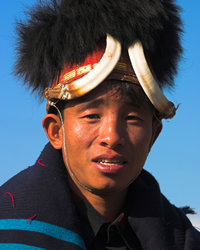Haqcyeng in Myanmar (Burma)

Photo Source:
Asia Harvest-Operation Myanmar
|
Send Joshua Project a map of this people group.
|
| People Name: | Haqcyeng |
| Country: | Myanmar (Burma) |
| 10/40 Window: | Yes |
| Population: | 400 |
| World Population: | 400 |
| Primary Language: | Language unknown |
| Primary Religion: | Christianity |
| Christian Adherents: | 85.00 % |
| Evangelicals: | 25.00 % |
| Scripture: | Unspecified |
| Ministry Resources: | No |
| Jesus Film: | No |
| Audio Recordings: | No |
| People Cluster: | South Asia Tribal - Naga |
| Affinity Bloc: | South Asian Peoples |
| Progress Level: |
|
Identity
“Haqcyeng” is the way the leaders of this group in Myanmar wish their name to be spelled. The only linguistic team known to have traveled to their area to survey their language also named them Haqcyeng. They are believed to be the most recent Tangshang group to migrate to the Pangsau area. They began arriving in 1981 and families continue to arrive today.
Location: Numbering just 400 people in Myanmar, the Haqcyeng are one of dozens of distinct Tangshang tribes in and around the small town of Pangsau in the country's Sagaing Region. The Haqcyeng straddle both sides of the Myanmar-India border, with similar populations in each country. In India, where they are commonly called “Hacheng,” many are employed in coalmines near their village. On one hand, “they are happy about the money they can earn. Also, the mine provides electricity and water much more reliably than the government can do. On the other hand, the acquisition of the plots now being mined was seen as a scam…as they were using the ignorance of the locals of what the black stone lying everywhere on the ground was used for.”
Language: The only study to have included the Haqcyeng vernacular was conducted by linguists in 2012. After surveying 145 tribe members and carefully evaluating word lists, they concluded that Haqcyeng is closely related to Ngaimong and Shangwan in Myanmar, and to the Yougli language spoken by over 1,000 people in the Indian state of Arunachal Pradesh. Because the communities where the Haqcyeng reside are shared with people from multiple groups, language use is also mixed. In some cases, people can speak other Tangshang languages better than they know the national Burmese language, but children today tend to be much more proficient in spoken and written Burmese than their parents.
History
As with many other tribes in this part of Asia, headhunting was practiced among the Haqcyeng for centuries, although the reasons given for why they indulged in the killing sprees vary. One source says: “The old ritual of headhunting is remembered as a fight over resources, whereas others interpret it as a fun game or sport with no real justification. Alliances between the tribes were made to promote collaboration, but if broken, the blood of men, women, and children was shed. Entire villages were leveled as a result.”
Customs
Having only arrived in the Pangsau area since 1981, the Haqcyeng people were permitted to settle in existing villages by other Tangshang groups. For example, 20 households of Haqcyeng live in Woktham Village, which they share with six other tribes. The village is dominated by Haqsik people, who inhabit around 100 households. On the Indian side of the border, Haqcyeng church leaders have tried to thread a needle between their tribal traditions and the teachings of the Bible. As a result, the Haqcyeng Baptists were involved with organizing a festival in the village of Malugaon, in an attempt to strike a balance between preserving their culture and honoring God.
Religion
Although almost all Haqcyeng people claim to be Christians today, a mixture of religious beliefs is often found among Tangshang tribes. Among the Haqcyeng in India, the Baptist church leaders “made sure their new religion would be in evidence at the festival. Besides the prayer and blessing to mark the beginning and the end of the festivities, three songs, sung by a church group comprising five girls…were also included in the cultural program.”
Christianity
Most Haqcyeng Christians are Baptists, but not having a Bible translation in their own language means that believers must use Burmese Bibles and songbooks in their services. This is far from ideal, especially for middle-aged and elderly believers who have often grown up with little or no knowledge of Burmese.